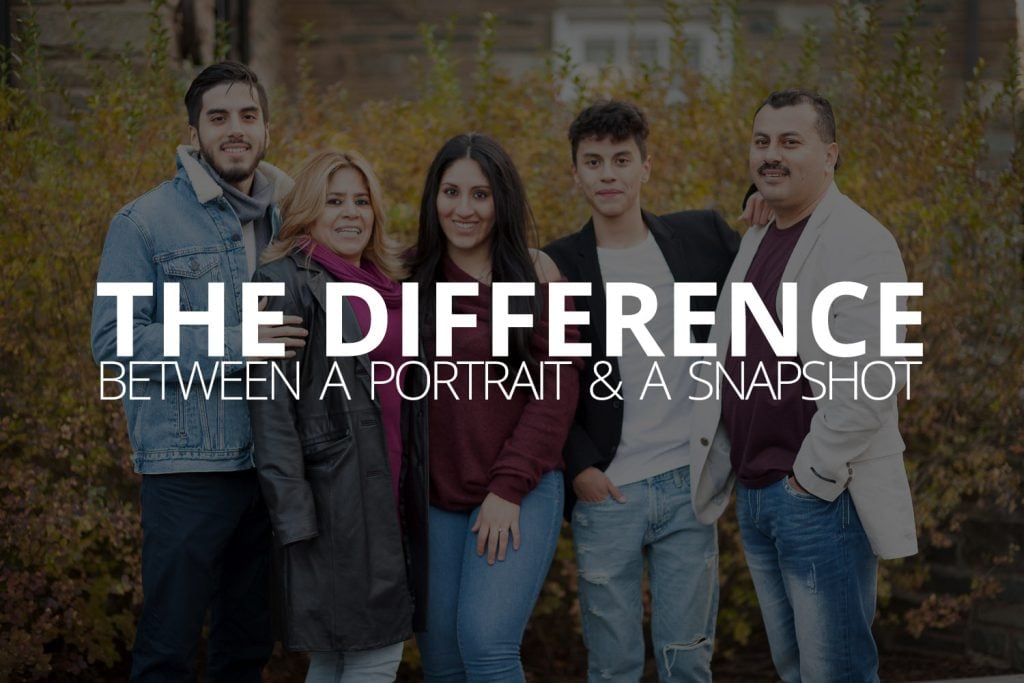We all take a lot of photos. Well, relatively speaking. We’re all taking thousands of times more photos today than say, people did 50 years ago. There are some obvious differences between the photo we take ourselves of the people we love on a daily basis—“snapshots”—and the photos that we commission someone else to create for us of the people we love—“portraits”.
Somewhere a technical guru is rolling their eyes over that use of language. But this isn’t written for them, it’s written for you. There’s a difference between the images a professional creates, and the images you take on your phone, or your point and shoot camera—or even that your family friend with a DSLR takes. The difference is careful attention to intentions and the skills to execute them.
For the sake of this article, I’m saying a “snapshot” is any image someone creates without really thinking about the resulting photo; any image created carelessly, and in this case, of a person. And, a “portrait” is an image of someone, created by someone else, who has a substantial focus on how the photo will look after it’s taken.
So what are the differences?
Technical Differences
There are plenty of technical differences between a “snapshot” and a “portrait”. For one thing, a portrait is going to be exposed just how the photographer intended, and the exposure will be even or uneven in just the way the photographer intended. A snapshot, on the other hand, might be too dark, or bright. Or it might be bright on the top and dark on the bottom. Skin tones might be washed out, and eyes might be bright red.
In a snapshot, important details might be left out, where in a portrait they would be carefully included. We’re talking about arms, and elbows and knees and feet, points of interest in the background, and the conscious choice of where to put the edge of the frame. The flip side of unintentional exclusion is unintentional inclusion; clutter is a problem in most snapshots too. When you pull out your phone and just point it and shoot, clutter that has become invisible to you in real life suddenly stands out in the snapshot. In a portrait, the photographer is avoiding the clutter, and trying to intentionally omit distracting details that take away from the image. And, In a snapshot, no one is thinking about how people will look sitting or standing the way they are. Looking great in a snapshot is always a stroke of luck. In a portrait, however, finding the angle, and the position where everyone looks their best is not just a consideration, it’s a priority.
Snapshots are also almost never processed after they’re taken. They look however the phone or camera thought they should look and a second thought is rarely given. In fact, a second thought is rarely even on the radar. A portrait on the other hand is processed to reflect the truth, or the overall impression, of a scene from the photographer’s own creativity, skill and intuition. Likewise, unflattering blemishes, unfortunate injuries and ill-timed pimples live on forever in a snapshot. But with a portrait, there’s a real artist somewhere pouring over the image to eliminate those temporary circumstances from defining an image or time in your life.
Emotional Differences
The most significant difference between a snapshot and a portrait isn’t really technical though. A big part of the difference is found in our emotional responses to our own investment in having the portraits created, and the satisfaction we get from finally receiving them.
Taking a snapshot is about as effortless as we can currently ask for. On most phones a single tap or swipe brings up the camera. Point, press, done. Do you ever go through your phone and discover photos you only barely remember taking? Or scrolled through a text message conversation to discover a photo a friend sent you a long time ago and you’d totally forgotten about? Probably. Most of us who’ve been living with smartphones for at least the past few years have. Snapshots absolutely have their place in our lives. I love rediscovering those images too, but I always soon forget about them again.
So what makes those images so forgettable? I submit that they are forgettable because they require nothing from us. They didn’t have to create any level of disruption to come into existence, or into our awareness. We don’t have to pause for them, and so our emotional machinery doesn’t get to register them as much more significant than any of the last 20 Instagram notifications that just happened to pop up on your phone.
In order to end up with a portrait in your hand, you have to feel something about it first. That’s the first step to registering something in your brain as important. Then you have to invest time to make it happen. By this point, your feeling something, and your doing something, and you’re setting yourself up for the results to matter to you. And finally, there’s a trade off required. Everyone has finite resources. Time, money, energy, patience. If you are having a portrait made, you’ve already decided that the portrait, or the experience, is more valuable to you that whatever else you could have done with those resources.
After all of that, the resulting portrait, unlike the snapshot, is going to stick in your mind. It’s going to stick to your walls. And thanks to all of that, it’s going to stand out in your memory.
Memory Differences
In my family, we have our own iconic images. They are images that stand out because they have existed in our lives for so long. Because we had to put up with my dad’s hobby to get them. We had to exercise patience. We had to decide to do the pictures, instead of something else. Every family photo was an investment. From the youngest (me), moaning about wearing a tie, to my parents who had to exercise a supernatural degree of grace and kindness not to lock me in the attic, everyone had to stretch themselves to some degree in the interest of walking away with a real family portrait.
Even as children of an enthusiastic photography hobbyist, as far as our day-to-day lives were concerned, making a nice portrait happen was out of the ordinary. Believe it or not, our memory does not work like a filing cabinet. In fact, the same mechanics that allow us to imagine crazy far-off fantasy worlds, are the same exact mechanics allowing us to remember that one day in spring when we all got together and made a beautiful family portrait together.
The less “ordinary” our experiences are from day to day, the more likely we are to remember any one of them. So when you take a snapshot, you’re staying well within the realm of what is ordinary, and you naturally forget all about it. (Some would argue that you’re even more likely to forget about it because you know the photo exists. The jury is still out, but I digress). But when you put in the effort and, outside of your norm, go work with a photographer to create an amazing portrait, you’re more likely to remember the experience of actually taking the picture, and by extension more likely to appreciate the picture itself as something meaningful and special.
If you’re in the process of raising kids, you might also find that the subtle qualities of your children’s personality stand out in your memory of a portrait session, better than they do in your memory of day to day snapshots. If you found this to be the case, it’s probably because the quirky personalities your kids are trying out only create friction when you have a goal you’re working toward. You know, like creating a great family portrait. Parents of small children sometimes quake at the things their kids say and do, and while the photographer is usually just chuckling at the silliness of childhood, sometimes those little things are finally being burned into the parent’s memory. Without those experiences, and the subsequent images to remind you of those experiences, they’re likely to drift into the vague haze of distant memory.
Historical Differences
There is one last consideration that I want to touch on when comparing a snapshot to a portrait: It’s the historical difference. No, I don’t mean national history, or global history. I’m talking about family and social history, and the sense of belonging that comes from seeing yourself showcased as a part of the family or social group.
Try to notice which photos people have put in frames in their homes. Are they snapshots, or are they portraits? They’re almost always portraits.
Because of all the examples I’ve laid out above, it’s the “portrait” that seems to have the most permission to exist within our real, physical lives. It’s the “portrait” that is invited into the picture album, and carefully enshrined beneath the glass, and between the wooden edges of a picture frame. It’s the portrait we want to be reminded we’re in, not the half drunken selfie at the bar. It’s the portraits we took on purpose that we want making up our real history, not the one’s and zero’s hidden on the computer in our pocket.

